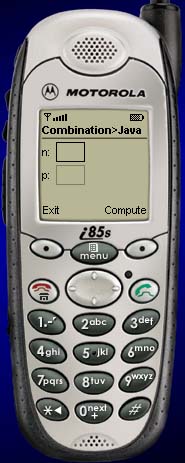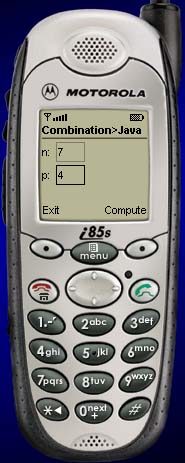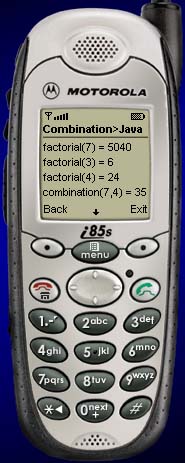   
 Purpose Purpose
This is the J2ME version of our combination
application.
 Requirements Requirements
You need J2ME (see tools section).
 Source
code Source
code
Below is the .java
file. For .jad, MANIFEST.MF
and .png, please
download the ZIP
file.
/*
* Combination.java
* J2ME
* Java
*/
package samples;
import javax.microedition.midlet.*;
import javax.microedition.lcdui.*;
/**
* A sample that computes factorial(n) and combination(n,p)
*/
public class Combination extends MIDlet implements CommandListener {
private Display display;
private Form frmIn, frmOut;
private TextField fieldN, fieldP;
private Command exitCommand = new Command("Exit", Command.EXIT, 1);
private Command computeCommand = new Command("Compute", Command.OK, 1);
private Command backCommand = new Command("Back", Command.BACK, 1);
/*
* Construct a new Combination.
*/
public Combination() {
display = Display.getDisplay(this);
}
/**
* Construct and display UI
*/
public void startApp() {
frmIn = new Form("Combination>Java");
frmIn.append(fieldN = new TextField("n: ", "", 4, TextField.NUMERIC));
frmIn.append(fieldP = new TextField("p: ", "", 4, TextField.NUMERIC));
frmIn.addCommand(exitCommand);
frmIn.addCommand(computeCommand);
frmIn.setCommandListener(this);
display.setCurrent(frmIn);
}
public void commandAction(Command c, Displayable s) {
if (c == computeCommand) {
int n = java.lang.Integer.parseInt(fieldN.getString()),
p = java.lang.Integer.parseInt(fieldP.getString());
go(n, p);
Display.getDisplay(this).setCurrent(frmOut);
}
else
if (c == backCommand) {
Display.getDisplay(this).setCurrent(frmIn);
frmOut = null;
}
else
if (c == exitCommand) {
destroyApp(false);
notifyDestroyed();
}
}
/**
* Time to pause, free any space we don't need right now.
*/
public void pauseApp() {
display.setCurrent(null);
frmIn = frmOut = null;
fieldN = fieldP = null;
}
/**
* Destroy must cleanup everything.
*/
public void destroyApp(boolean unconditional) {
}
public long factorial(int n) {
return (n <= 1) ? 1 : n*factorial(n-1); // he-he... let's mix a ternary operator (?) and recursion...
}
public long combination(int n, int p) {
return factorial(n) / (factorial(n - p) * factorial(p));
}
public void go(int n, int p) {
frmOut = new Form("Combination>Java");
frmOut.append("factorial(" + n + ") = " + factorial(n) + "\n");
frmOut.append("factorial(" + (n-p) + ") = " + factorial(n-p) + "\n");
frmOut.append("factorial(" + p + ") = " + factorial(p) + "\n");
frmOut.append("combination(" + n + "," + p + ") = " + combination(n, p) + "\n");
frmOut.addCommand(exitCommand);
frmOut.addCommand(backCommand);
frmOut.setCommandListener(this);
}
}
 Comments Comments
We'll only import a minimal
set of J2ME classes. Just enough for our simple UI. Please note
that this J2ME version of combination runs on a Palm
as is (the .prc is
in the ZIP file mentioned above). If you'd like to deploy this app
to a Java phone, you'll need to use a specific tool to package it
and upload it on the device.
The UI is created in startApp(),
events are handled in commandAction(Command
c, Displayable s).
The core functions are located at the end of the .java
file: factorial(), combination()
and go().
   
Next sample 
|




